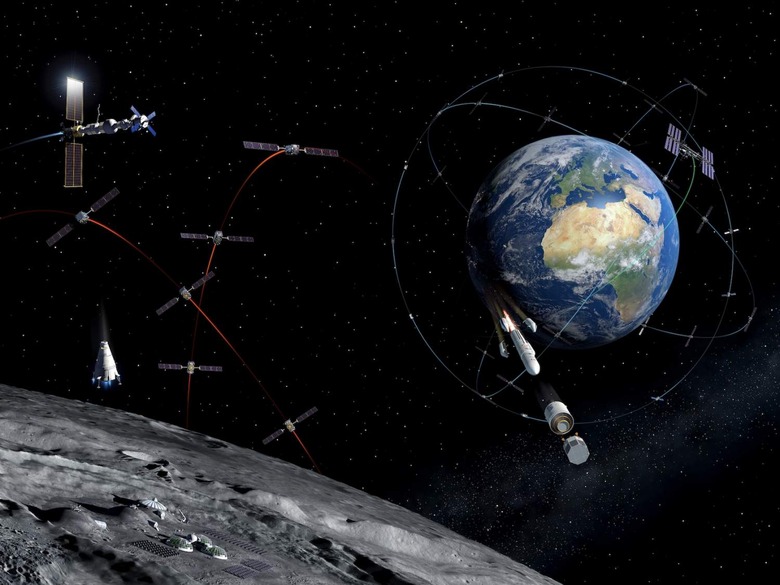ESA Pushes Ahead On Starlink-GPS Style Hybrid Network For The Moon
An incredible network of lunar satellites, ringing the Moon and powering a telecoms and navigation system there, is another step closer to reality, the European Space Agency has announced today. The ESA's Moonlight plan would address one of the growing areas of concern as humanity plans a crewed return to the lunar surface, delivering stable communications between teams and back with mission control on Earth.
Currently, communications between the Moon and Earth are fairly bottlenecked. The Moon itself blocks radio signals, which means that any probe, spacecraft, or crewed mission to the far-side of Earth's satellite is cut off from direct transmissions to and from us.
China's Chang'e-4 lander, for example, relied upon a relay satellite in the Earth-Moon L2 Lagrangian point. That satellite, Queqiao, effectively acts as an intermediary, taking communications from the lander and then relaying them to Earth. What the ESA has in mind, though, is considerably more complex – and more powerful.
A series of satellites positioned around the Moon could blanket it in coverage, both for communications and for a GPS-style navigation system. It would avoid the need for lunar missions to establish a relay of their own, or use high-power transmitters capable of reaching Earth independently. As a result, the ESA suggests, future missions could be even more accessible.

"Using a shared telecommunications and navigation service would reduce the design complexity of future individual missions and make them lighter, freeing space for more scientific instruments or other cargo, making each individual mission more cost-efficient," the Agency points out.
"Lowering the ticket price to lunar exploration could empower a wider group of ESA member states to launch their own national lunar missions," it's suggested. "Even on a relatively low budget, an emerging space nation would be able to send a scientific CubeSat mission to the Moon, inspiring the next generation of scientists and engineers."
To begin with, the ESA plans to demonstrate the potential of such a system with the Lunar Pathfinder comsat. Set to launch by the end of 2023, it'll establish an orbit around the Moon and deliver navigation and data relay information. The goal is positioning accuracy of around 100 meters, though future satellites could halve that or better.
The ESA is also providing NASA with the ESPRIT communications module for the upcoming Artemis program. Moonlight will tap technologies from both those projects, to build out a lasting network for the Moon.
It'll take a while, unsurprisingly, for that to be realized. The ESA has just inked deals with two consortia – one led by Surrey Satellite Technology Ltd, working with Airbus and others; the other led by Telespazio, working with Inmarsat, Canada's MDA, and others – to figure out the logistics and details.
"A robust, reliable and efficient telecommunications and navigation system will make the dozens of individual missions planned for the Moon more cost-efficient and enable smaller countries to become space-faring nations, inspiring the next generation of scientists and engineers," Elodie Viau, Director of Telecommunications and Integrated Applications at the ESA, said today of the agreements.
NASA's Artemis mission aims to return astronauts to the surface of the Moon by 2024. It also intends to build a Lunar Gateway, a new space station positioned near the Moon, which would act as a staging post both for lunar descent and – in future – missions further afield to Mars and other planets in our solar system.
